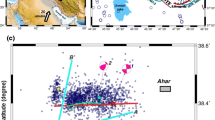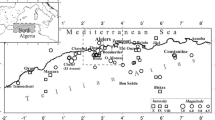Abstract
The 25 November 2016 Aketao, Xinjiang earthquake occurred on the northeastern margin of the Pamir plateau, rupturing the Muji fault on the northern segment of the Kongur Extensional System. We collected coseismic offsets at 7 GPS sites, which show that the fault experienced significate dextral slip with a near-field geodetic displacement of up to 12 cm along the strike. The joint inversion of GPS data and teleseismic P waveforms suggests a complex rupture pattern characterized by the unilateral propagation slip from the epicenter to the southeast for 60 km with a total seismic moment of ~ 1.3 × 1019 Nm, corresponding to a magnitude of Mw 6.7 earthquake. Our model of slip distribution shows two major slip patches with a slip amplitude up to ~ 0.6 m, one located at shallow depths of 0–8 km close to the hypocenter with apparent surface breaks and the other, ~ 40 km to the southeast, buried at a greater depth of ~ 12 km. The rupture is dominated by a right-lateral strike slip with significant normal-slip components. The near-field GPS data enhances the spatial resolution of source model. Based on the preferred slip model, the static Coulomb Failure Stress change caused by 2016 Aketao earthquake suggests that the unzipped western and eastern ends of Muji fault and the northern segment of Kungai Fault are significantly promoted.







Similar content being viewed by others
References
Altamimi, Z., Collilieux, X., & Mėtivier, L. (2011). ITRF2008: An improved solution of the international terrestrial reference frame. Journal of Geodesy, 85(8), 457–473. https://doi.org/10.1007/s00190-011-0444-4.
Brunel, M., Arnaud, N., Tapponnier, P., Pan, Y., & Wang, Y. (1994). Kongur Shan normal fault: Type example of mountain building assisted by extension (Karakoram fault, eastern Pamir). Geology, 22(8), 707–710.
Burtman, V. S. (2000). Cenozoic crustal shortening between the Pamir and Tien Shan and a reconstruction of the Pamir-Tien Shan transition zone for the Cretaceous and Palaeogene. Tectonophysics, 319, 69–92.
Chen, J., Li, T., Li, W. Q., & Yuan, Z. D. (2011). Late Cenozoic and present tectonic deformation in the Pamir salient, Northwestern China. Seismology and Geology, 02, 241–259.
Chen, J., Li, T., Sun, J., Fang, L., Yao, Y., Li, Y., et al. (2016). Coseismic surface ruptures and seismogenic Muji fault of the 25 November 2016 Aerketao Mw6.6 earthquake in northern Pamir. Seismology and Geology, 38, 1160–1174. (in Chinese).
Chen, W., & Molnar, P. (1977). Seismic moment of major earthquake and the average rate of slip in central Asia. Journal of Geophysical Research, 82, 2945–2967.
Feng, W. P., Tian, Y., Zhang, Y., Samsonov, S., Almeida, R., & Liu, P. (2017). A slip gap of the 2016 Mw6.6 Muji, Xinjiang, China, earthquake inferred from Sentinel-1 TOPS interferometry. Seismological Research Letters, 88(4), 1–11.
Herring, T., King, R., & McCluskey, S. (2010). Introduction to GAMIT/GLOBK release 10.4. Cambridge: Massachusetts Institute of Technology.
Hertzell, S. H., & Heaton, T. H. (1983). Inversion of strong ground motion and teleseismic waveform data for the fault rupture history of the 1979 Imperial Valley, California earthquake. Bulletin of the Seismological Society of America, 73(6A), 1553–1583.
Ide, S., Takeo, M., & Yoshida, Y. (1996). Process of the kobe earthquake: Determination of spatio-temporal slip distribution by bayesian modeling. Bulletin of the Seismological Society of America, 386, 547–566.
Jiang, Z., Wang, M., Wang, Y., Wu, Y., Che, S., Shen, Z., et al. (2014). GPS constrained coseismic source and slip distribution of the 2013 Mw6.6 Lushan, China, earthquake and its tectonic implications. Geophysical Research Letters, 41, 407–413. https://doi.org/10.1002/2013gl058812.
Jiang, G., Wen, Y., Liu, Y., Xu, X., Fang, L., Chen, G., et al. (2015). Joint analysis of the 2014 Kangding, southwest China, earthquake sequence with seismicity relocation and InSAR inversion. Geophysical Research Letters, 42, 3273–3281. https://doi.org/10.1002/2015GL063750.
Kikuchi, M., & Kanamori, H. (1991). Inversion of complex body wave-III. Bulletin of the Seismological Society of America, 81, 2335–2350.
King, G. C., Stein, R. S., & Lin, J. (1994). Static stress changes and the triggering of earthquakes. Bulletin of the Seismological Society of America, 84, 935–953.
Li, W. Q., Chen, J., Yuan, Z. D., Huang, M. D., Li, T., Yu, S., et al. (2011). Coseismic surface ruptures of multi segments and seismogenic fault of the Tashkorgan earthquake in Pamir, 1895. Seismology and Geology, 33(2), 260–276.
Liu, G., Wang, Q., Qiao, X., Yang, S., You, X., Zhang, R., et al. (2015a). The 25 April 2015 Nepal Ms8.1 earthquake slip distribution from joint inversion of teleseismic, static and high-rate GPS data. Chinese Journal of Geophysics, 58, 4287–4297. (in Chinese).
Liu, C., Zheng, Y., Wang, J., & Xiong, X. (2015b). Kinematic rupture process of the 2014 Chile Mw8.1 earthquake constrained by strong-motion, GPS static offsets and teleseismic data. Geophysical Journal International, 202, 1137–1145.
Qiao, X., Wang, Q., Yang, S., Li, J., Zou, R., & Ding, K. (2015). The 2008 Nura Mw6.7 earthquake: A shallow rupture on the main pamir thrust revealed by GPS and InSAR. Geodesy and Geodynamics, 6, 91–100.
Qiao, X., Yu, P., Nie, Z., Li, J., Wang, X., Kuzikov, S., et al. (2017). The crustal deformation revealed by GPS and InSAR in the northwest corner of the Tarim Basin, northwestern China. Pure Applied Geophysics, 174, 1405–1423.
Robinson, A. C., Yin, A., Manning, C. E., Harrison, T. M., Zhang, S. H., & Wang, X. F. (2004). Tectonic evolution of the northeastern Pamir: Constraints from the northern portion of the Cenozoic Kongur Shan extensional system, western China. Geological Society of America Bulletin., 116, 953–973.
Shan, B., Xiong, X., Wang, R., Zheng, Y., & Yang, S. (2013). Coulomb stress evolution along Xianshuihe-Xiaojiang Fault System since 1713 and its interaction with Wenchuan earthquake, May 12, 2008. Earth and Planetary Science Letters, 377, 199–210.
Shen, Z. K., King, R., Agnew, D., Wang, M., Herring, T., Dong, D., et al. (2011). A unified analysis of crustal motion in Southern California, 1970-2004: The SCEC crustal motion map. Journal of Geophysical Research, 116, B11402.
Shen, Z. K., Wan, Y. G., Gan, W. J., Zeng, Y. H., & Ren, Q. (2003). Viscoelastic triggering among large earthquakes along the eastern Kunlun fault system. Chinese Journal of Geophysics, 46(6), 786–795.
Sippl, C., Schurr, B., Yuan, X., Mechie, J., Schneider, G. M., Orunbaev, S., et al. (2013). Geometry of the Pamir-Hindu Kush intermediate-depth earthquake zone from local seismic data. Journal of Geophysical Research, 118, 1438–1457.
Stein, R. S., Barka, A. A., & Dieterich, J. H. (1997). Progressive failure on the North Anatolian fault since 1939 by earthquake stress triggering. Geophysical Journal International, 128, 594–604.
Teshebaeva, K., Sudhaus, H., Echtler, H., Schurr, B., & Roessner, S. (2014). Strain partitioning at the eastern Pamir-Alai revealed through SAR data analysis of the 2008 Nura earthquake. Geophysical Journal International, 198, 760–774.
Wang, S., Xu, C., Wen, Y., Yin, Z., Jiang, G., & Fang, L. (2017). Slip Model for the 25 November 2016 Mw 6.6 Aketao Earthquake, Western China, Revealed by Sentinel-1 and ALOS-2 Observations. Remote Sensing, 9, 325.
Wang, Q., Zhang, P. Z., Freymueller, J. T., Bilham, R., Larson, K. M., Lai, X. A., et al. (2001). Present-day crustal deformation in China constrained by global positioning system measurements. Science, 294, 574–577.
Xie, Z., Zheng, Y., Liu, C., Shan, B., Riaz, M., & Xiong, X. (2017). An integrated analysis of source parameters, seismogenic structure, and seismic hazards related to the 2014 Ms6.3 Kangding earthquake, China. Tectonophysics, 712, 1–9.
Xiong, W., Tan, K., Liu, G., Qiao, X. J., & Nie, Z. S. (2015). Coseismic and postseismic Coulomb stress changes on surrounding major faults caused by the 2015 Nepal Mw7.9 earthquake. Chinese Journal Geophysics, 58(11), 4305–4316. https://doi.org/10.6038/cjg20151135.
Xu, X. W., Jiang, G. Y., Yu, G. H., Wu, X. Y., Zhang, J. G., & Li, X. (2014). Discussion on seismogenic fault of the Ludian Ms6.5 earthquake and its tectonic attribution. Chinese Journal Geophysics, 57(9), 3060–3068. https://doi.org/10.6038/cjg20140931.
Yin, A., Nie, S., Craig, P., Harrison, T. M., Ryerson, F. J., Xianglin, Q., et al. (1998). Late Cenozoic tectonic evolution of the southern Chinese Tian Shan. Tectonics, 17, 1–27.
Yoshida, S., & Koketsu, K. (1990). Simultaneous inversion of waveform and geodetic data for the rupture process of the 1984 Naganoken-Seibu, Japan, earthquake. Geophysical Journal International, 103, 355–362.
Yoshida, S., Koketsu, K., Shibazaki, B., Sagiya, T., Kato, T., & Yoshida, Y. (1996). Joint inversion of near- and far-field waveforms and geodetic data for the rupture process of the 1995 Kobe Earthquake. Journal of Physics Earth, 44, 437–454.
Yue, H., & Lay, T. (2013). Source rupture models for the Mw9.0, Tohoku earthquake from joint inversions of high-rate geodetic and seismic data. Bulletin of the Seismological Society of America, 103(2), 1242–1255.
Zhang, L., Li, J., Liao, W., & Wang, Q. (2016). Source rupture process of the 2015 Gorkha, Nepal Mw7.9 earthquake and its tectonic implications. Geodesy and Geodynamics, 7, 124–131.
Zhang, Y., Wang, R., Chen, Y., Xu, L., Du, F., Jin, M., et al. (2014). Kinematic rupture model and hypocenter relocation of the 2013 Mw6.6 Lushan earthquake constrained by strong-motion and teleseismic data. Seismological Research Letters, 88, 15–22.
Zhang, X., Yan, C., Xu, L., & Li, C. (2017). Source complexity of the 2016 Aketao Ms6.7 earthquake and its intensity. Chinese Journal of Geophysics, 60, 1411–1422.
Acknowledgements
The GPS data in Aketao were from the Engineering Research Center of the China Crust Movement Observation Network and Earthquake Agency of Xinjiang Uygur Autonomous Region, Earthquake Administration of the Xinjiang Uygur Autonomous Region. Special thanks to surveyors who perform GPS observations in the Pamir plateau after Mw 6.6 Aketao earthquake. This study was sponsored partly by the National Natural Science Foundation of China (No. 2016063063, 41374030, 41574012, 41404016).
Author information
Authors and Affiliations
Corresponding author
Rights and permissions
About this article
Cite this article
Li, J., Liu, G., Qiao, X. et al. Rupture Characteristics of the 25 November 2016 Aketao Earthquake (Mw 6.6) in Eastern Pamir Revealed by GPS and Teleseismic Data. Pure Appl. Geophys. 175, 573–585 (2018). https://doi.org/10.1007/s00024-018-1798-9
Received:
Revised:
Accepted:
Published:
Issue Date:
DOI: https://doi.org/10.1007/s00024-018-1798-9




